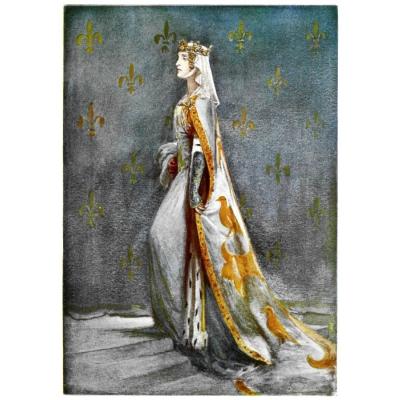
Posted in: World Wedding Customs
 For a Medieval wedding, the bride wore her finest dress and robe. Pictured here is Anne of Bohemia, Queen of Richard II. Illustration by Percy Anderson for Costume Fanciful, Historical and Theatrical, 1906, Public Domain.
For a Medieval wedding, the bride and groom chose the very best of their jewelry and attire to wear. For the lower classes, this might mean opting for the same dress they wore for other special occasions. However, those of royal or noble class typically commissioned new outfits for the occasion.
For a Medieval wedding, the bride wore her finest dress and robe. Pictured here is Anne of Bohemia, Queen of Richard II. Illustration by Percy Anderson for Costume Fanciful, Historical and Theatrical, 1906, Public Domain.
For a Medieval wedding, the bride and groom chose the very best of their jewelry and attire to wear. For the lower classes, this might mean opting for the same dress they wore for other special occasions. However, those of royal or noble class typically commissioned new outfits for the occasion.
A Note About Medieval Wedding Fashion
The Middle Ages span a number of centuries. For this reason, Medieval fashion changes depending on which century you study. Furthermore, several European countries influenced Medieval customs. Therefore, the fashions of one country might differ from those of a neighboring country. For the scope of this article, I've focused only on the fashions that endure to this present time. As such, for those who closely study the Middle Ages, this article may frustrate you. For that, I apologize in advance.Medieval Bridal Attire
The Medieval costumes of today resemble closely the attire a Medieval bride would have worn. Indeed, a bride wore the long velvet dress in beautiful jewel tones with golden buttons lining the bodice and skirt. Called a cotehardie, this magnificent garment trailed all the way to her ankles and featured fitted sleeves with buttons down the length. In terms of color, most brides chose dark blue, the color of purity. These wealthier Medieval brides often chose shades of red or gold. Royals and nobles chose materials such as velvet, satin, or silk. Of course, a woman hoped for a silk dress above all others. Sometimes, a wealthier bride chose brocade silk with elaborate patterns called roundels. For brides of a lower social status, dresses fashioned from linen or cotton resembled, as much as possible, those worn by ladies of status. Underneath it all, no matter her status, a Medieval bride wore a chemise and breast band, as well as knee-length stockings. Meanwhile, over their entire outfit, she wore a beautiful cloak with a long train. The most elaborate Medieval robes featured long hanging sleeves and jeweled metalwork belts.Bridal Jewelry in the Middle Ages
These jeweled belts, as well as the jeweled brooches used to fasten their cloaks prove the most common jewels worn by Middle Age brides. With the heavy fabrics and almost all her skin covered, these were about the only places a bride could fit jewelry into her ensemble. However, she more than made up for the absence of jewelry by donning an elaborate headdress. To this day, the elaborate cone-shaped hennin with wimple remains a staple of Medieval costume. As an alternative, a Medieval bride might have worn a silk toque or a calotte with a gold circlet. She might also choose a crownless turret made of linen or silk. The majority of these headdresses were fashioned from silk or linen, depending on the bride's social status. Additionally, many featured a chin strap. Brides of royal blood might wear a jeweled crown with a wimple.A Medieval Groom's Attire
Like their brides, Medieval grooms also wore a cotehardie. As time marched on, the men wore shorter and shorter hemlines, so that the cotehardie transformed into the doublet, which resembles a contemporary tuxedo vest or jacket. Underneath, a man wore loose-fitting linen breeches held up by a jeweled belt. He also wore a linen tunic. His leather-soled hose eliminated the need for shoes. A man tied his hose directly to his breeches, to his belt, or to his snug-fitting doublet. Doublets featured elaborate buttons and terminated at the hips. Over the top of the whole, a Medieval groom wore a woolen robe, tunic, or kirtle. This garment might have fallen to his calves, his knees, or somewhere in between. Men of all classes wore metalwork belts, sometimes jeweled. Worn low on the hips, these belts served to hold a belt pouch for currency and a long dagger worn at a diagonal. A wealthy groom's dagger featured a intricate jeweled hilt and scabbard. Men also wore headdresses. A Medieval groom might have worn a richly-colored moire hat with a wide white brim. Another option, a velvet biretta with a white linen coif might have also featured a row of pearls. He also might have worn his hair curled with a felt hat featuring a pleated band and white linen coif. To this day, Medieval wedding costumes remain a favorite among certain groups. What do you think? Would you wear a Medieval gown instead of a traditional white wedding dress? ~Angela Magnotti Andrews5 years ago
88 view(s) 